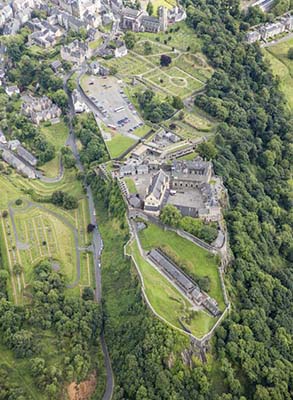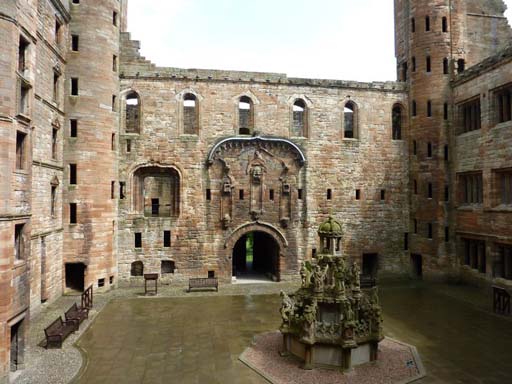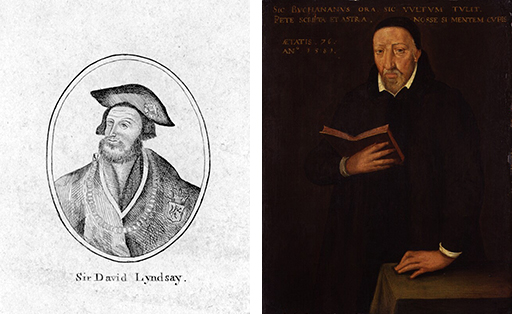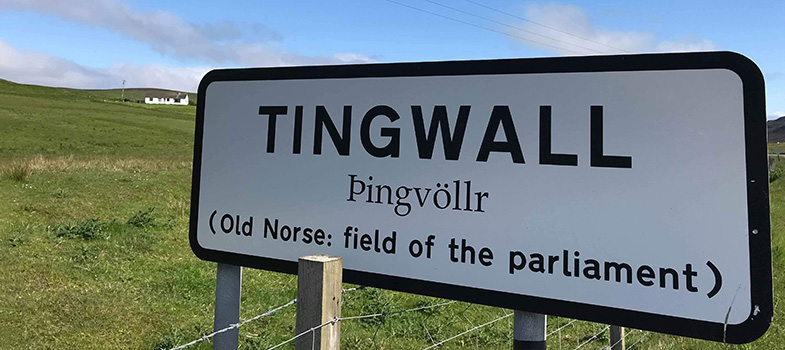9.1 Scots on stage (1700–)
In this section you will learn about the history of Scots language drama and, briefly, theatre in Scotland and more recent use of Scots on stage, television and in film. The related activities will assist you in developing your knowledge and experience of the use of Scots in performance and, so, your understanding of Scots language. You are encouraged to seek out the texts mentioned later in libraries and also as performed in clips on YouTube.

There is a myth that theatre in Scotland after the 1560 Reformation was suppressed for centuries. In fact, as Anna Mill says in her masterly study of medieval plays in Scotland, ‘the drama was employed by the early reformers as a valuable means of propaganda’ (1927, p. 88).
Leading up to the Reformation, the Catholic Church with its widespread clerks’ plays had used drama to spread its version of Christianity and those who opposed its organisation and values had also used drama to promote their views. The playwright and friar John Kyllour’s Historye of Christis Passioun, performed on Good Friday 1535 on the Stirling playfield in front of King, court and townspeople, clearly attacked the contemporary clergy’s pomposity. The Catholic hierarchy hunted him down and he was burned at the stake in Edinburgh in 1539.
When in the next year the first version of David Lindsay’s Thrie Estaitis, a satire on clerical and political corruption, was performed at court in Linlithgow, Lindsay was protected by his high position at court, as Lindsay was a Scottish herald and makar, who gained the highest heraldic office of Lyon King of Arms. Yet, after his play, expanded for the public, was presented in Cupar (1552) and Edinburgh (1554), the script was burned publicly. Suppression of controversial theatre preceded the Scottish Reformation.

As in many other countries, drama and theatre was lively and alert to current topics, participating in dynamic debate. It was for that reason that over the centuries theatre was often watched carefully by the authorities: throughout Britain, for example, after 1737 the Lord Chamberlain, the official in charge of the royal household, acted as theatre censor until that duty was abolished as recently as 1968.Much of the impact of Lindsay’s play lay in its vibrant Scots. In fact, Lindsay was not the first major playwright Scotland produced.
Around 1540 George Buchanan produced two original plays, Jephthes and Baptistes, two versions of Greek tragedies which had a Europe-wide impact on theatrical development, powerfully influencing the development of French neo-classical drama by playwrights like Corneille and Racine in the next century and being performed and translated across Europe from Portugal to Poland for well over two hundred years. But Buchanan’s plays were in Latin and Lindsay’s were, like the folk drama that surrounded him, in Scots.

During the early modern period, from about 1500 to 1800, Scottish schoolchildren were required to perform plays at least annually for Kirk Sessions and local bigwigs, not least in order to develop their public speaking skills – a tradition that has lasted to the present day with schoolchildren performing plays, for example the Christmas play, at their school.
The plays performed by children before 1800 might be classical or contemporary, but what they mark is the strength of a theatre tradition outside of the professional playhouse, a form which only came to prominence in Scotland during the 18th century, by the end of which it was wide-spread. In spreading, it could draw on the long tradition of serious drama in the schools that produced the governing classes – the lawyers, ministers, politicians and teachers – and on the parallel forms of folk and amateur drama.
Many theatre plays were written in English, but so were many in Scots, like Allan Ramsay’s Jacobite-supporting The Gentle Shepherd (1729).
By the 19th century, as Walter’s Scott’s novels emerged to public acclaim, they were quickly adapted for the stage, and toured throughout Scotland, where their main home, but not only source, was Edinburgh’s Theatre Royal. These dramas drew on Scots dialogue, especially for local characters, and constituted what was called the National Drama. Through that century such plays marked a distinctive Scottish genre, using Scots for key dialogue and asserting the individuality of Scottish history, literature and culture.
While this long tradition of Scottish drama and theatre did not produce the sort of masterpieces which appeared within the English theatre, one should never underestimate the range and depth of Scottish theatrical history, especially since the Reformation, and the importance of Scots language drama within that tradition.
Certainly, in Ane Satire of the Thrie Estaitis and The Gentle Shepherd it produced two lasting masterpieces in Scots language, while The Gentle Shepherd and the Scot John Home’s Douglas (1756), the latter written in English, were two of the most produced and successful plays in British theatre in their century and for decades beyond.
In this next activity you will identify the most important language information from this section.
Activity 5
Which of these highly influential plays by Scottish playwrights were written in which language? Select the correct answer for each play.
a.
English
b.
Latin
c.
Scots
The correct answer is a.
a.
English
b.
Latin
c.
Scots
The correct answer is c.
a.
English
b.
Latin
c.
Scots
The correct answer is c.
a.
English
b.
Latin
c.
Scots
The correct answer is a.
a.
English
b.
Latin
c.
Scots
The correct answer is b.
In this next activity you will identify the most important factual information from this section.
Activity 6
Which of these statements are true and which are false according to the information given in the course text above?
a.
True
b.
False
The correct answer is b.
Answer
False – It was John Kyllor, a friar and member of the clergy himself, who was burnt at the stake in Edinburgh.
a.
True
b.
False
The correct answer is a.
a.
True
b.
False
The correct answer is b.
Answer
False – As censorship of plays was abolished in 1968, the Lord Chamberlain acted as theatre censor between 1737 and 1968.
a.
True
b.
False
The correct answer is a.
a.
True
b.
False
The correct answer is b.
Answer
False – The schoolchildren were required to perform for Kirk Sessions and local bigwigs, not least to practise their public speaking skills.
a.
True
b.
False
The correct answer is b.
Answer
False - The professional playhouse came to prominence during the 18th century and was well established at the end of that century.
a.
True
b.
False
The correct answer is b.
Answer
False – These plays toured Scotland as well
a.
True
b.
False
The correct answer is a.
9. Introductory handsel
